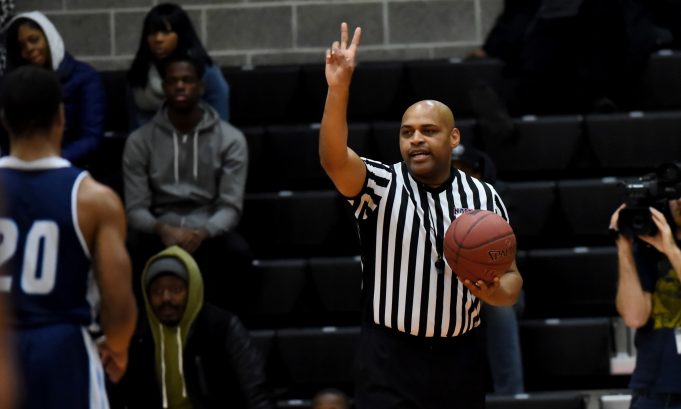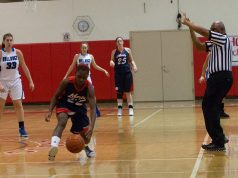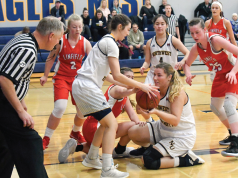During any game, a mistake by an official or scorer can be made. For officials marked by inattentiveness and indifference, change “can” to “will likely.” For officials working with scorekeepers and timers who are, at best, willing volunteers and not-so-adequately trained, change that to “will eventually.” Some mistakes can be fixed right away (inadvertent whistle), some within a certain timeframe only (wrong throw-in team), some by the end of the game (bookkeeping errors) and some will cost the coach and the team (changing the scorebook due to an incomplete roster or incorrect number, etc.).
There is, however, a special class of mistakes that can and should be rectified according to a special protocol: correctable errors. Their number is set by rule — there are only five (NFHS 2-10; NCAAM/W 2-12). Their resolution is set by rule as well. Let’s review some tips on how you as an official and as a crew can minimize the correctable errors that otherwise might happen to you.
You’ll want to study, both personally and in your small groups, the relevant sections of the rulebook and casebook for your respective level of play. Know the five correctable errors by heart. Be able to state the timeframes within which any of those five can be corrected. There is the handy chart in the NFHS and NCAAW rulebooks that may help your understanding of this unique timeframe aspect of correctable errors. Know how to resume play after the correction has been made.
But even better, know — and pregame with your crew every game — how best to avoid correctable errors in the first place. Though inattentive table personnel can sometimes be to blame for these free-throw mistakes and scoring errors, good, vivid, clear, redundant crew communication can be a safety, a check, a reliable barrier against a correctable error.
 Some ideas for avoiding a correctable error:
Some ideas for avoiding a correctable error:
Have the referee, in that brief meet-and-greet with the table personnel, tell the timer, “Please do not advance the team foul number until after we report to you the fouler’s number.” If the timer cooperates, this will reduce the number of correctable errors by about 80 percent. When you glance at the scoreboard on the way to the table, you want to be sure the number of team fouls is what it is before you report that foul. That way you’ll be clear on whether it’s a bonus or a throw-in happening next. That advice expressed to the timer can help assure you of that.
When you call a foul, slow yourself down. Know for sure — before you leave where you are — who fouled and, if there’s going to be a free thrower, who that free thrower is going to be. If there’s no “bonus,” point to the spot of the ensuing throw-in and verbalize loud enough for your partner(s) to easily hear, “White throw-in.”
In the confusion of the play, don’t lose who the fouler is. Partners, by virtue of your wider court awareness, be able to say to your crewmate who called the foul, “I’ve got your shooter.” And get that player to the free-throw line while the fouler is being reported to the table. If there is no shooter because the team isn’t yet in the bonus, there’s no harm in having picked the potential shooter out. A good habit is to get the shooter all the time, then verbalize and use that information when there’s a bonus situation.
When reporting to the table, clarity and precise expression are imperative. Get to the reporting area. Stop. Do not — repeat, do not — report while on the move. Stop in the reporting area. Slow down. Report the color loudly and clearly. If the scorer’s head is down and he or she isn’t looking at you, do not report the foul until you have eye contact. Digitize the numbers with your fingers without flashing the digits too quickly. Combine your digitization with a clear and boldly expressed number of the fouler. Thus, “Blue … 24.” Always verbalize the number. That scorer needs your voice to confirm exactly who the foul was on. After this, you can give the signal and verbalization of the kind of foul that occurred. If there’s going to be a free throw (or multiple free throws), end the report with the number of shots with those digits the last sign you give to the table.
Then, just keep that arm up in the air, turn toward the floor and keep it up from where you’re at until your partner administering the free throw visually acknowledges that number, then issues the same digital signal while communicating to the players lined up along the lane and the shooter the number of free throws. Your other partner (if working three-person mechanics) should mirror both you and your partner. Thus, there should be either two or three signals with the number of free throws up in the air at the same time, confirming among all partners the accurate number of free throws to be shot. If the number of free throws is wrong, either the table or one of the crewmates should identify that, with that much repetition going on. Catching a mistake is much more likely with this much redundancy built into your reporting habits.
Repetitive? Yes. Redundant? You bet. Ridiculous? Not if you want to avoid a correctable error. And remember this: As difficult as it is for officials to learn the unique intricacies about correctable errors, it’s about 10 times as difficult for coaches, players and fans to understand how they’re properly corrected. In other words, do whatever you and your crew can to avoid a correctable error in the first place.
What's Your Call? Leave a Comment:
Note: This article is archival in nature. Rules, interpretations, mechanics, philosophies and other information may or may not be correct for the current year.
This article is the copyright of ©Referee Enterprises, Inc., and may not be republished in whole or in part online, in print or in any capacity without expressed written permission from Referee. The article is made available for educational use by individuals.


















